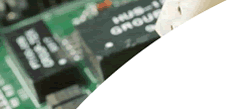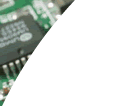The
Maths
The integrity of the solder joint is related to the
amount of solder paste deposited by the stencil. The amount of paste
is simply determined by the "volume" of the hole in the
stencil. For a rectangular hole this volume is determined by Width
X Length X Height. The ideal volume however may be difficult to achieve.
A limiting factor exists which adds complexity to the determination
of the design of the stencil.

The
Variable
This limiting factor variable relates to the ability
of the solder paste to stick on the PCBs pad area rather then remaining
stuck in the stencil cavity. This is normally referred to as the solder
paste "release" characteristic. The properties which determine
this are basic and straight forward to understand. The first is the
ratio of the area of the SMD pad compared to the area of the walls
inside the stencil cavity. It is easy to see that if the area of the
walls of the stencil cavity is greater then the area of contact of
the solder paste to the PCB pad, that the solder paste will have a
tendency to remain in the stencil cavity.
The second is the mechanical structure and shape
of the stencil cavity walls. If the walls are rough, they will tend
to "hold-on" to the solder paste. Similarly if the walls
are tapered with the top opening smaller than the bottom opening the
same will happen. For this reason alone, laser cutting provides a
far superior finish and hence, a superior stencil.
It must also be noted that Lead Free solder pastes
have been found to have a lower release characteristic than traditional
lead based solder pastes.
The
Problem
Inherent to the SMD stencil technology is the problem
that it is not possible to design a stencil which will deposit the
ideal amount of solder paste on every PCB pad unless every pad is
exactly the same size. As the size of the pads increase, ideally the
amount of paste should be increased by increasing the height of the
stencil. Inherently though, this would create a situation where the
small holes in the stencil would not release the paste. As a result,
the design of the stencil must be based on the smallest pad, with
the "hope" that the largest pad will get by with the deficit
of solder paste. This problem gets worse as the gap between the smallest
and largest component on the board increases.
The
Solution
In some situation it is not possible to find a suitable
balance. In these cases, a final solution to tackle the problem exists.
This solution is to re-design the PCB so that the smallest footprint
SMT components are at 45degrees to the direction to which the stencil
is lifted from the screen board. This technique allows the smaller,
more susceptible deposits of solder paste to be effectively "peeled"
off with only one corner of the paste leaving the stencil cavity initially
and hence reducing the stencils dominance in holding onto the paste.
This technique also has the added benefit of enabling the squeegee
process to more evenly and reliably deposit the solder paste into
the stencil cavity.
The
Stencil Calculator
Taken these factors into account our Paste
Stencil Calculator provides a solid guideline as to the design
of the stencil and in particular to the stencil thickness to deposit
a "suitable" amount of solder paste into the PCB pads. It
must be kept in mind that the final stencil design will be a compromise,
trying to find a "sweet spot" which will work for all the
different components on the board.
The
End



